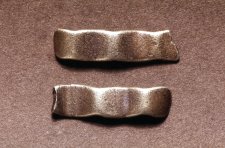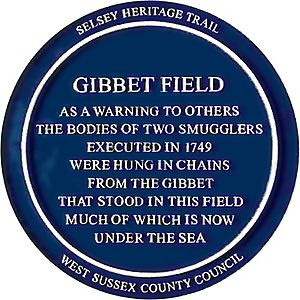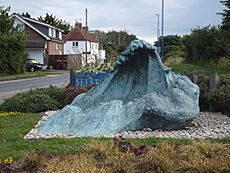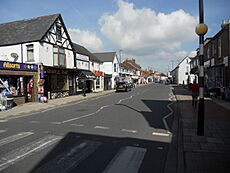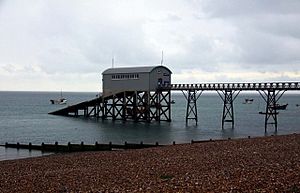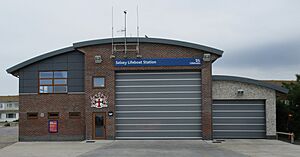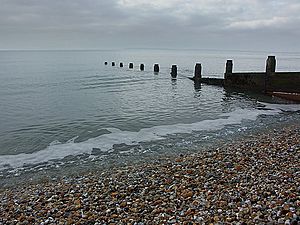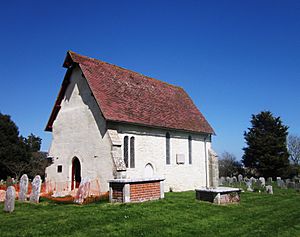Selsey facts for kids
Quick facts for kids Selsey |
|
|---|---|
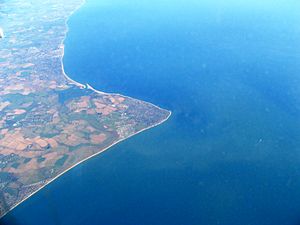 Aerial view |
|
| Area | 12.28 km2 (4.74 sq mi) |
| Population | 10,737 (2011 Census) |
| • Density | 804/km2 (2,080/sq mi) |
| OS grid reference | SZ854935 |
| • London | 60 miles (97 km) NNE |
| Civil parish |
|
| District |
|
| Shire county | |
| Region | |
| Country | England |
| Sovereign state | United Kingdom |
| Post town | CHICHESTER |
| Postcode district | PO20 |
| Dialling code | 01243 |
| Police | Sussex |
| Fire | West Sussex |
| Ambulance | South East Coast |
| EU Parliament | South East England |
| UK Parliament |
|
| Website | http://www.selseytowncouncil.gov.uk/ |
Selsey (/ˈsɛlsi/) is a fun seaside town and parish in West Sussex, England. It's about eight miles (12 km) south of Chichester. Selsey is at the very end of the Manhood Peninsula, almost surrounded by the sea. It has Bracklesham Bay to the west and Pagham Harbour to the east. The town ends at Selsey Bill in the south.
Under the sea near Selsey, there are big rock formations called the Owers rocks and Mixon rocks. The coastline here often changes because of erosion (the sea wearing away the land). In 2011, about 10,737 people lived in Selsey.
The B2145 is the only road that goes in and out of Selsey. It crosses a bridge over the water at Pagham Harbour, a place known as "the ferry." Long ago, Selsey used to be cut off when the tide was high. A boat was kept at the ferry to take people and horses across the water.
Contents
What's in a Name?
Some people think the name "Selsey" means "Holy Island." This is because of its connection to a saint named Wilfrid. However, a writer called the Venerable Bede said that "Selsey" meant "the Isle of Sea Calves." Sea calves are another name for seals, so it could mean "Seal Island."
A local expert, Edward Heron-Allen, found at least twenty different ways Selsey's name has been spelled over time! Here are a few examples:
- Seoles – This is an Old English spelling.
- Seleisi – This spelling was used in the Domesday Book in 1086.
- Celesye – This spelling appeared in a record from 1279.
Selsey's Story Through Time
People have lived in the Selsey area for a very long time, even back in the Stone Age! Tools made of stone have been found that date back to the Palaeolithic period. This shows that people have been here for thousands of years.
During the Iron Age, a tribe called the Atrebates might have built a city in Selsey. It could have been like other important towns before the Romans arrived. So far, archaeologists haven't found proof of this city. Some people think the "old city" mentioned by William Camden was at the Mixon rocks, which are now under the sea.
Many old coins have been found in Selsey. Gold coins from Atrebates rulers like Commius and Verica were found on the beach in 1877. These coins were probably made nearby. Later, Roman coins were used, and they have been found too. Some Anglo-Saxon gold pieces with runic writing were also found on the beach. These pieces, from the 6th to 8th century, are now in the British Museum.
Selsey was once the capital of the Kingdom of Sussex. Around 680 AD, a person named Wilfrid came to Selsey and helped turn the kingdom into a Christian one. There was an important church called Selsey Abbey in Selsey, probably where Church Norton is today. This was the main church for the Sussex area until 1075, when the church moved to Chichester.
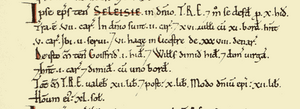
Selsey is mentioned in the Domesday Book, a famous survey from 1086. It says that the Bishop of Chichester owned Selsey. The land was used for farming, with fields and workers. The Bishop continued to own Selsey until 1561.
In July 1588, the Spanish Armada (a large Spanish fleet) sailed near the Isle of Wight. The wind changed, and some local people thought of a plan to trick the Spanish fleet onto the Owers rocks near Selsey. But the Spanish admiral saw the danger and decided to sail to Calais instead.
Cricket has been played in Selsey for a long time. In 1647, a sad event happened during a cricket match in Selsey. A player named Henry Brand was hit on the head by the batsman, Thomas Latter, and died.
For centuries, Selsey made money from the sea, and one way was through smuggling. In the 1700s, Selsey Bill was very isolated. The only way to the mainland was a causeway that was covered at high tide. This made it easy for smugglers to bring in goods without being caught. People even say that the local church leaders would claim a share of the smuggled goods! There were also stories of a secret tunnel from the Old Rectory (at Church Norton) to an old mound.
Some Selsey men even ran regular ferry services to France, bringing in goods. In 1749, some smugglers from the famous Hawkhurst Gang were accused of murder. Seven of them were sentenced to death. The bodies of two smugglers, John Cobby and John Hammond, were hung in gibbets at Selsey Bill. This was a warning to others and could be seen from far away.
Selsey got its first school in the early 1800s. In 1818, a building was given to the church to be used as a free school for poor children. The local government took over the school in 1937.
From 1897 to 1935, Selsey was connected to Chichester by a special train line. It was called the Hundred of Manhood and Selsey Tramway. The trains were old and not very fast, so people nicknamed it the "Selsey Snail"! Funny postcards were even made about its slow service.
Selsey Today
Shopping and Holidays
Selsey has a main street with different shops and places to eat. It's a popular holiday spot with many holiday cottages, bed and breakfasts, and large caravan parks. Selsey also has some small factories and a fishing fleet that catches fish from the sea.
Sports and Fun

Football
Selsey Football Club started in 1903. It's a semi-professional football club that plays in local leagues.
Cricket
Cricket has been played in Selsey since at least 1647. The Selsey Cricket Club officially started on July 9, 1834. They won their first recorded match by 3 runs!
A famous former president of the club was Hubert Doggart. He played for England in two Test matches in 1950. He was also president of the Marylebone Cricket Club (M.C.C.). Selsey Cricket Club has teams for men, ladies, and several junior teams.
Arts in Selsey
Many artists come to Selsey because of its wide landscapes, coastal views, and different types of birds. These artists often belong to a group called Arts Dream Selsey Artists. They hold art shows and events regularly. Famous artists like Whistler and J. M. W. Turner have featured Selsey in their artwork.
Holiday Park
On the west side of Selsey, you'll find the Seal Bay holiday park, a popular place for visitors to stay.
Learning in Selsey
Selsey has a secondary school called The Academy, Selsey. It also has two primary schools: Seal Primary School (now Seal Academy) and Medmerry Primary School.
Before and after the Second World War, there were also private schools in Selsey. One of them, Broombank School, was in the old home of a famous entertainer, Bransby Williams. This school was known for its music and arts programs.
Selsey Lifeboat Station
Selsey has an RNLI (Royal National Lifeboat Institution) lifeboat station. It was started in 1861. The RNLI helps rescue people at sea. In 2014, Selsey had a Tyne-class lifeboat and a smaller D Class Inshore Lifeboat.
In 2011, the Selsey Lifeboat Station celebrated 150 years of saving lives. During that time, the lifeboat crew received 10 awards for their bravery! A new boathouse was built on the shore. The last launch from the old boathouse was on April 1, 2017. The new boathouse holds both the inshore lifeboat and a new, faster Shannon-class lifeboat.
Special Places in Selsey
The Selsey area has a couple of Sites of Special Scientific Interest (SSSIs), which are places protected for their special wildlife or geology. Bracklesham Bay is one of these, running along the coast.
Medmerry Mill is an old tower windmill that was fixed up in the 1960s. Today, it's a gift shop.
St Peter's Church is the main church in Selsey. It was built in the 13th century. Interestingly, the church building was originally located at Church Norton, about 2 miles north of where it is now. It was moved to its current spot at the entrance to Selsey High Street in the 1800s.
Famous People from Selsey
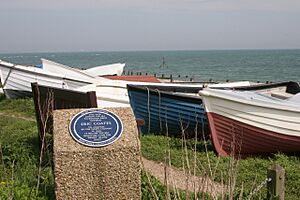
- Eric Coates (1886–1957) – This composer lived and worked in Selsey. He wrote the famous tune By the Sleepy Lagoon after looking out at the sea. You might know this song as the theme tune for the radio show Desert Island Discs.
- Air Commodore Edward 'Teddy' Mortlock Donaldson (1912–1992) – He was a pilot who set a new world air speed record of 616 mph in 1946! He lived in Selsey, and there's a blue plaque on the beach to remember his achievement.
- Edward Heron-Allen (1861–1943) – He was a very important resident of Selsey in the early 1900s. He wrote a classic book about the local history of the area.
- David Hewlett (1968– ) – This British-Canadian actor lived in Selsey for a while. He's best known for playing Dr. Rodney McKay in the TV show Stargate Atlantis.
- Sir Patrick Moore (1923–2012) – A famous astronomer, writer, and TV presenter, Sir Patrick lived in Selsey from 1968 until he passed away. He was also an active member of the Selsey Cricket Club.
- R. C. Sherriff (1896–1975) – This writer, famous for his play Journey's End, had a holiday home in Selsey. He even started writing his play in a railway carriage bungalow on Selsey Bill!
Weather and Nature
In 1998, a tornado hit Selsey. It caused about £10 million worth of damage and even damaged Patrick Moore's observatory!
In 2015, around 50 Smooth-hound sharks were seen near the beach in Selsey.
Getting Around Selsey
Roads
The B2145 road to Chichester is the only road that goes in and out of Selsey. It crosses a bridge over the water at Pagham Harbour.
Buses
The Stagecoach South 51 bus route runs from Chichester bus station to Selsey. There's also a special Selsey Community Shuttle Bus, run by the Selsey Town Council. It helps people from the outer parts of town get to the center for shopping or appointments.
Selsey Venture Club
The Selsey Venture Club has a voluntary minibus service. It helps older or less mobile residents get around and take part in local activities.
Airports and Train Stations
The closest airport to Selsey is Southampton. Other nearby airports include Gatwick, Bournemouth, and Heathrow.
Selsey no longer has its own train station. The train line between Chichester and Selsey closed in 1935. The closest train stations are now in Chichester and Bognor.
See also
 In Spanish: Selsey para niños
In Spanish: Selsey para niños



